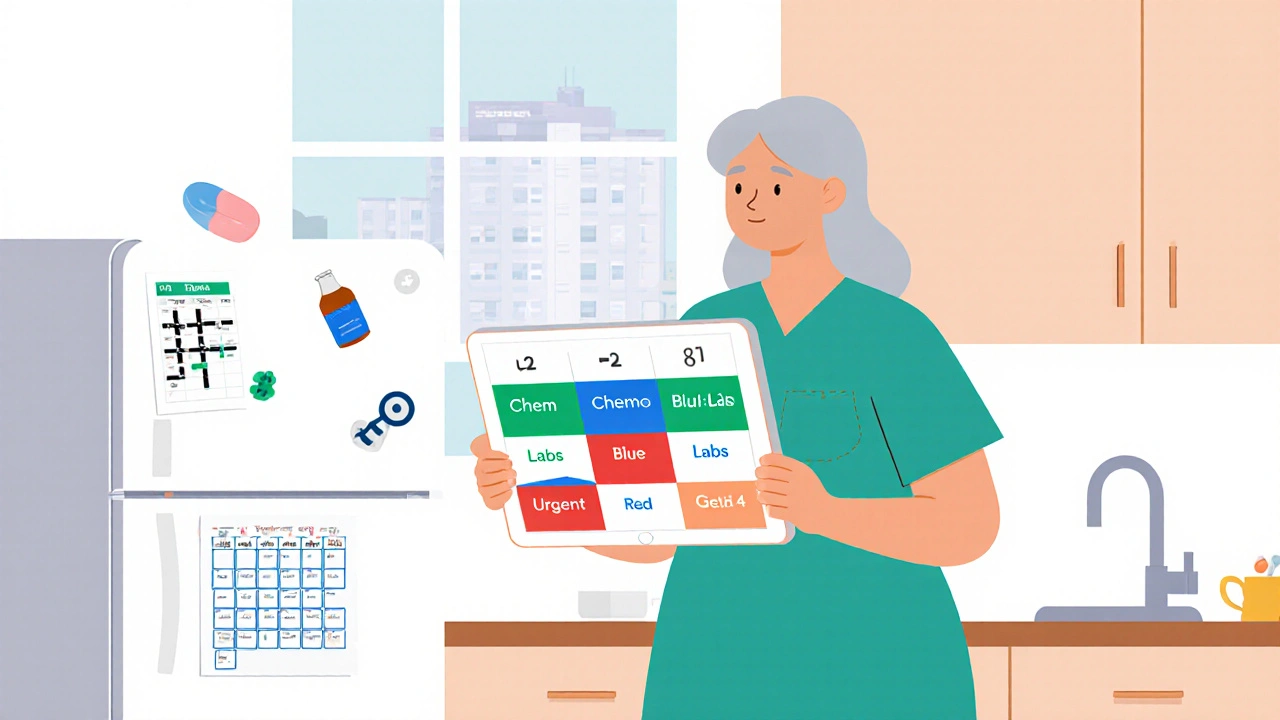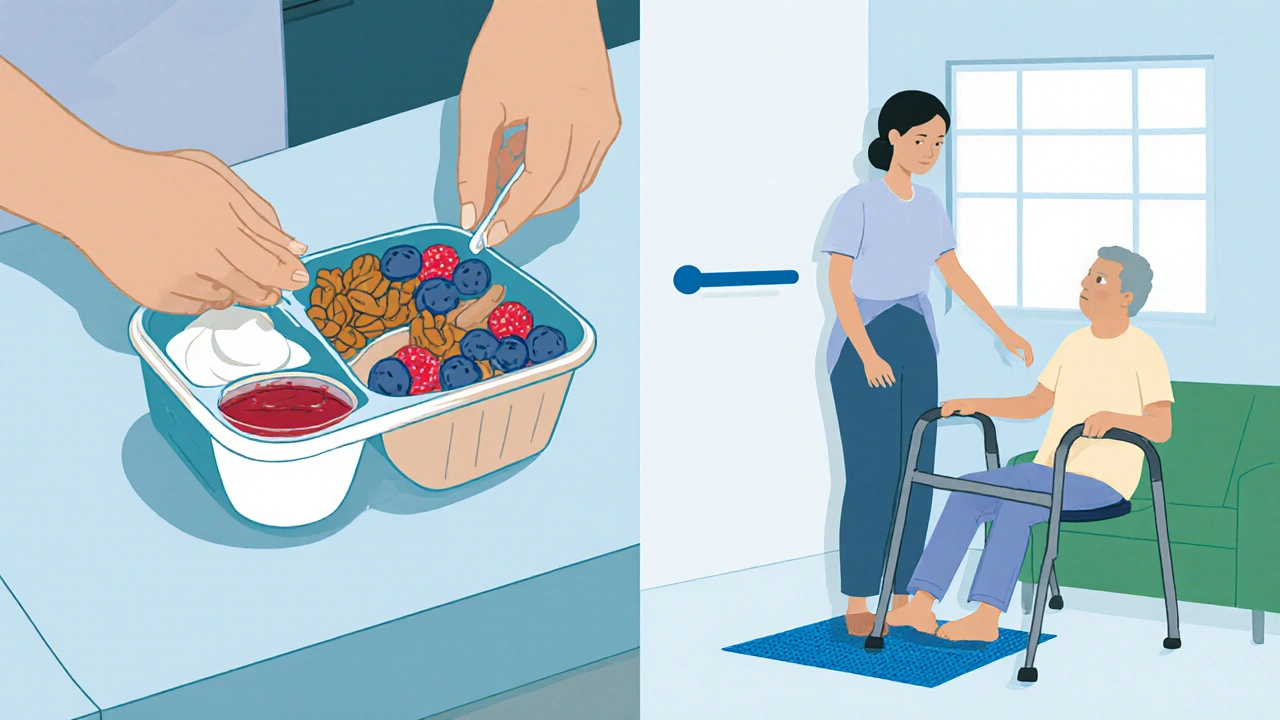
Myeloma Medication Tracker
Medication Tracking Tool
Track your loved one's medication schedule, dosages, and side effects to ensure proper treatment management.
Current Medication Schedule
When a family member receives a multiple myeloma diagnosis, the world can feel like it’s shifting under your feet. You want to do everything right, but the sheer amount of medical jargon, appointments, and emotional ups and downs can leave even the most caring person overwhelmed. This guide breaks down the essential steps, practical tools, and everyday habits that make myeloma caregiving more manageable and, most importantly, more supportive for the person you love.
Understanding Multiple Myeloma
Multiple Myeloma is a cancer of plasma cells, a type of white‑blood cell that lives in the bone marrow. When these cells multiply uncontrollably, they crowd out healthy blood‑forming cells, weaken bones, and release abnormal proteins that can damage kidneys. According to the International Myeloma Working Group, about 34,000 new cases are diagnosed in the United States each year, and the disease is more common in adults over 60.
For caregivers, grasping the basics-what the disease does, how it’s treated, and what symptoms to watch-creates a solid foundation for all the day‑to‑day decisions you’ll face.
Core Caregiver Responsibilities
Every caregiving journey looks different, but most families find themselves handling three main categories: medical logistics, daily living support, and emotional wellbeing.
- Medical logistics: tracking appointments, managing medication schedules, and communicating with the oncology team.
- Daily living support: helping with hygiene, nutrition, and mobility when fatigue or bone pain limits independence.
- Emotional wellbeing: providing reassurance, listening without judgment, and connecting to outside resources.
Below you’ll find tips and tools for each area, anchored in real‑world examples from caregivers in Sydney, Melbourne, and beyond.
Medical Logistics Made Simple
Medical coordination can feel like a full‑time job. Here are proven strategies to stay organized.
1. Build a Master Calendar
Use a shared digital calendar (Google Calendar works well) and color‑code entries: green for chemo sessions, blue for lab work, red for urgent follow‑ups. Sync the calendar to every family member’s phone so no one misses a dose.
2. Create a Medication Matrix
Most myeloma patients take a cocktail of drugs - a proteasome inhibitor, an immunomodulatory agent, steroids, and supportive meds like bisphosphonates. Chemotherapy is the cornerstone of treatment, often delivered in cycles lasting 21 days. Print a table that lists each drug, dosage, timing, side‑effects to watch, and a checkbox for daily administration. Keep the matrix on the refrigerator for quick reference.
3. Leverage Hospital Portals
Australian health services now offer online patient portals where test results appear in real time. Set up alerts so you receive a notification the moment a new report is posted. This cuts down phone‑calling and lets you act promptly if a lab value needs attention.
4. Prepare for Appointments
Before each visit, jot down three concise questions. Bring a notebook or a voice recorder (with consent) to capture the oncologist’s answers. Common queries include:
- What is the goal of the next treatment cycle?
- How should we manage neuropathy?
- When is the next imaging study scheduled?
Supporting Daily Living
Myeloma’s symptoms-fatigue, bone pain, anemia-can make everyday tasks feel monumental. Small adjustments can protect dignity and reduce strain.
Nutrition and Hydration
Good nutrition helps combat treatment‑related weight loss and supports bone health. Nutrition should focus on high‑protein foods, calcium‑rich dairy or fortified alternatives, and plenty of fruits and vegetables. Small, frequent meals are easier to tolerate than large plates. A simple tip: prepare a “grab‑and‑go” snack box with Greek yogurt, nuts, and berries-these provide protein, healthy fats, and antioxidants.
Physical Activity
Gentle movement maintains muscle mass and reduces bone‑pain spikes. Physical Therapy can design a low‑impact routine-think seated leg lifts, arm circles, and short walks with a walker if needed. Even a five‑minute stretch after waking can improve circulation.
Pain Management
Bone pain is a hallmark of myeloma. Work with the pain team to establish a baseline regimen-often a combination of NSAIDs, low‑dose opioids, and bisphosphonates. Bone‑targeted therapy, such as zoledronic acid, helps reduce skeletal events. Keep a pain diary noting intensity, triggers, and medication timing; share it with the oncologist every month.
Home Safety
Fall risk rises as fatigue and neuropathy set in. Install grab bars in the bathroom, use non‑slip mats, and keep pathways clear of cords. If stairs are a challenge, consider a portable stair lift or move the bedroom to the ground floor.
Emotional and Psychosocial Support
Being diagnosed with myeloma is emotionally taxing for both patient and caregiver. Ignoring the mental health side can lead to burnout.
Active Listening
Instead of offering solutions right away, validate feelings. Phrases like, “I hear how scary this is for you,” open space for the patient to vent.
Professional Counseling
Many hospitals provide psycho‑oncology services. A therapist trained in cancer care can teach coping tools such as mindfulness, guided imagery, and anxiety‑reduction breathing exercises.
Support Groups
Connecting with others walking the same path reduces isolation. In Sydney, the Myeloma Support Network meets monthly at St. Vincent’s Hospital. Online forums like Myeloma.org also offer a global community.
Respite Care
Taking a break isn’t selfish-it’s essential. Hourly respite services, day‑programs, or short‑term stays at a palliative‑care facility give you time to recharge, preventing caregiver fatigue.

Practical Tools and Resources
Below is a quick‑reference table that condenses the most useful tools for myeloma caregivers.
| Tool | Purpose | Suggested Provider |
|---|---|---|
| Shared Calendar (Google, Outlook) | Track appointments, med times | Free - online |
| Medication Matrix Sheet | Daily drug coordination | Print‑out template (download) |
| Patient Portal (My Health Record) | Lab results, messages | Australian Government |
| Pain Diary App (e.g., PainScale) | Record pain levels, meds | iOS/Android |
| Support Group (Myeloma Support Network) | Peer connection | Local hospitals |
Common Pitfalls & How to Avoid Them
Even the best‑prepared caregivers stumble. Here are the top three mistakes and quick fixes.
- Over‑scheduling: Packing the day with appointments leaves no room for rest. Block “buffer” periods-15 minutes between visits-to catch up on paperwork or simply breathe.
- Ignoring Your Own Health: Skipping meals or sleep can lead to burnout. Set a daily reminder to eat, hydrate, and stretch.
- Going It Alone: Refusing help often means you miss out on valuable assistance. Ask a sibling to drive to the next chemo session or enlist a neighbor for grocery runs.
Next Steps for New Caregivers
Feeling a bit overwhelmed after reading all this? Start with three bite‑size actions today:
- Set up a shared calendar and add the next two medical appointments.
- Print a medication matrix and fill in today’s doses.
- Call one local support group and ask about upcoming meetings.
These small wins build momentum and give you a clearer view of what’s ahead.
How often should a myeloma patient see their oncologist?
During active treatment, visits are typically every 3-4 weeks for chemotherapy infusions, then every 2-3 months for maintenance phases. After completing therapy, most patients transition to a surveillance schedule of every 3-6 months, depending on disease stability.

What are the most common side‑effects of myeloma treatment?
Patients often experience fatigue, peripheral neuropathy (tingling in hands/feet), nausea, and increased infection risk due to low white‑blood‑cell counts. Bone pain can persist, especially before bone‑strengthening meds take effect.
Can caregivers administer oral chemotherapy at home?
Yes, many oral agents (e.g., lenalidomide, pomalidomide) are taken at home. Strict adherence to dosing schedules and safe handling-wearing gloves, disposing of waste properly-are crucial. Always follow the pharmacy’s counseling sheet.
What nutritional supplements are safe during myeloma treatment?
A daily multivitamin with calcium and vitamin D is generally safe. High‑dose antioxidants (e.g., mega‑dose vitamin C) may interfere with chemotherapy and should only be used under doctor supervision.
How can I manage the emotional toll of caregiving?
Schedule weekly “check‑in” calls with a friend or counselor, practice mindfulness for 5 minutes each morning, and use respite services regularly. Remember, caring for yourself is the first step in caring for your loved one.

erica fenty
October 21, 2025 AT 17:31Leverage the oncology portal; sync alerts, track labs-reduces admin friction. Utilize a medication matrix, visualize dosing cycles, mitigate errors.
eric smith
October 21, 2025 AT 18:04Oh, because you obviously needed a reminder to color‑code your calendar-thank goodness someone’s pointing out the obvious.
Erika Thonn
October 21, 2025 AT 18:37In the quiet of the waiting roo, we confront the mutable nature of hope; it is both a compass and a mirage.
The caregiver's journey, it seems, is a dialogue between resilence and the inexorable tide of uncertainty.
Ericka Suarez
October 21, 2025 AT 19:11Our beloved nation stands tall, even when cancer tries to crush our spirit! We will not bow to the silent thief; we fight with heart, with blood, with undying pride.
Chirag Muthoo
October 21, 2025 AT 19:44I commend the comprehensive approach presented herein; it provides a robust framework for caregivers. Maintaining personal health, as emphasized, is essential to sustain long‑term support.
Angela Koulouris
October 21, 2025 AT 20:17Think of the caregiver role as a garden-nurture each need with patience, water the moments of joy, and prune the stressors when they overgrow.
Harry Bhullar
October 21, 2025 AT 20:51Alright, let’s break this down step by step, because the devil’s in the details. First off, a shared digital calendar isn’t just a convenience; it’s a lifeline when chemo cycles, labs, and follow‑ups start overlapping like a jam session. Color‑code each event-green for infusion days, blue for labs, red for urgent consults-and sync it across every family member’s device. Second, the medication matrix should be printed, laminated, and stuck on the fridge; think of it as a cheat sheet that lists drug names, dosages, timing, and side‑effect checkpoints. Third, never underestimate the power of the hospital’s patient portal; set up push notifications so you get a ping the instant a new result lands, saving you endless phone tag. Fourth, before each oncology appointment, draft three bullet‑point questions-keep them tight, no rambling, and bring a voice recorder (with consent) to capture the doctor’s answers verbatim. Fifth, nutrition matters: aim for high‑protein snacks like Greek yogurt with berries, and keep hydration levels high to flush out metabolites. Sixth, gentle movement is key; even a five‑minute stretch routine in the morning can improve circulation and curb fatigue. Seventh, pain management should be proactive-a pain diary noting intensity, triggers, and medication timing can guide dosage adjustments. Eighth, safety modifications at home, like grab bars and non‑slip mats, are non‑negotiable once neuropathy sets in. Ninth, emotional wellness isn’t optional; schedule weekly check‑ins with a counselor or a peer support group, even if it’s a short Zoom call. Tenth, remember to schedule respite care-hourly in‑home help or a day program can prevent caregiver burnout. Eleventh, keep your own health on the radar: set alarms for meals, hydration, and micro‑breaks. Twelfth, consider a dedicated “caregiver inbox” in your email to funnel all lab reports, pharmacy notes, and appointment reminders in one place. Thirteenth, involve siblings or extended family early; delegate tasks like grocery runs or transport to spread the load. Fourteenth, always have an emergency contact list on hand, including the oncology nurse line, pharmacy, and local emergency services. Finally, celebrate the small wins-maybe a pain score drop or a good night’s sleep-because those moments fuel the long haul.
Lolita Gaela
October 21, 2025 AT 21:24The integration of a pain‑scale app aligns with evidence‑based symptom monitoring protocols, enhancing data fidelity and enabling timely clinician interventions.